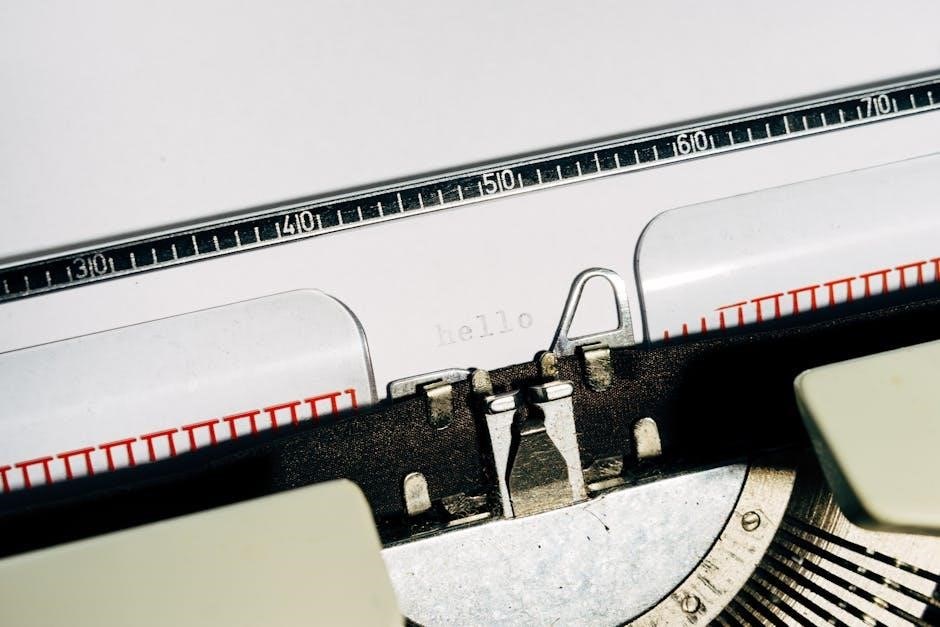Print manuals are essential guides for understanding and troubleshooting printing processes, ensuring clarity and efficiency in producing high-quality documents while addressing common user challenges effectively always․
1․1 What is a Print Manual?
A print manual is a comprehensive guide providing detailed instructions for printing processes, troubleshooting, and optimizing output․ It serves as a reference for users to understand printer operations, resolve common issues, and achieve high-quality results․ Print manuals are tailored for both novice and advanced users, offering step-by-step instructions and technical specifications․ They often include information on paper handling, ink management, and maintenance tips to ensure efficient printing․ These manuals are essential for anyone seeking to master printing techniques, whether for personal or professional use, and are typically available in digital or physical formats for convenience․
1․2 Importance of Print Manuals in Printing Processes
Print manuals are crucial for ensuring efficiency, accuracy, and consistency in printing operations․ They provide clear guidelines that help users navigate printer settings, troubleshoot issues, and optimize output quality․ By following these manuals, individuals can avoid common pitfalls, such as paper mismatch errors or incorrect ink usage, which can lead to wasted resources․ Additionally, print manuals often include tips for maintaining printers, extending their lifespan and performance․ This makes them indispensable for both personal and professional environments, ensuring that printing tasks are completed effectively and professionally․
1․3 Brief History of Print Manuals
Print manuals have evolved alongside printing technology, serving as essential guides since the advent of movable type․ Early manuals were simple guides for operating presses, while modern versions are comprehensive resources․ The rise of digital printing brought detailed troubleshooting sections and optimized settings for various paper types․ Today, print manuals are often digital, offering interactive features and real-time updates․ Their historical development reflects advancements in printing, ensuring users can maximize efficiency and quality․ From basic operation guides to advanced troubleshooting, print manuals remain vital for both personal and professional printing needs, adapting to technological changes while maintaining their core purpose of aiding users effectively always․

Understanding Printer Settings for Manual Printing
Printer settings for manual printing involve configuring manual feed modes, adjusting paper type and size, and troubleshooting common issues like paper mismatch errors and driver-related problems effectively always․
2․1 Manual Feed Mode Explained
Manual feed mode requires users to load each sheet of paper individually into a specific tray, often for special paper types or sizes․ This mode ensures precise control over printing materials like labels or envelopes, which may not be compatible with standard trays․ Printers typically prompt for manual intervention when expecting a specific paper type or size․ Setting up manual feed mode involves adjusting printer settings or using a dedicated manual feed slot․ While it demands more user involvement, manual feed mode offers flexibility for unique printing needs, ensuring high-quality output for specialized documents․ It is particularly useful for professional results with custom paper stock․ Printers often default to this mode when detecting mismatched paper settings․ Properly configuring manual feed mode ensures smooth operation and prevents common printing errors․
2․2 Adjusting Paper Type and Size Settings
Accurately setting the paper type and size is crucial for optimal printing results․ Mismatched settings can cause errors or poor print quality․ To adjust these settings, access the printer control panel or software and select the correct paper type (e․g․, plain, label, or photo paper) and size (e․g․, A4, Letter, or custom)․ Ensuring these settings match the loaded paper prevents issues like paper jams or misalignment․ Proper configuration guarantees precise printing and high-quality output, reducing the risk of common printing problems such as paper mismatch errors․ Always verify settings before initiating a print job to achieve professional and consistent results․ This step is essential for both manual and automated printing processes․
2․3 Troubleshooting Common Manual Feed Issues
Manual feed issues often arise due to incorrect paper type or size settings, misaligned paper, or printer driver problems․ If the printer prompts for manual intervention despite paper being loaded, check if the settings match the paper in the manual tray․ Ensure the paper is loaded correctly and the tray is aligned properly․ Paper mismatch errors can occur if the printer expects a different size or type․ Additionally, outdated or incorrect printer drivers may cause unexpected behavior․ Restarting the printer or reinstalling drivers often resolves these issues․ Always verify settings before printing to avoid disruptions and ensure smooth manual feed operation․

Step-by-Step Guide to Printing Manuals
Printing manuals involves preparing documents, selecting the right printer, loading paper into the manual tray, and initiating the print job with correct settings for quality output always․
3․1 Preparing Your Document for Printing
Preparing your document for printing involves several key steps to ensure high-quality output․ First, review the content for accuracy and clarity, ensuring all text and images are correct․ Next, adjust the formatting, such as font size, margins, and alignment, to meet your printing needs․ Check the page setup to confirm the correct paper size and orientation are selected․ Proofread the document to catch any spelling or grammatical errors․ Save the file in a compatible format, like PDF, to preserve formatting across devices․ Finally, verify that the printer settings match the document’s requirements, such as paper type and print quality, before initiating the print job․
3․2 Choosing the Right Printer for Manual Printing
Selecting the appropriate printer for manual printing is crucial for achieving desired results․ Consider printers with manual feed capabilities, ensuring compatibility with your document’s paper type and size․ Inkjet printers often excel in color accuracy, while laser printers are ideal for sharp text․ Check for driver support and compatibility with your operating system to avoid issues․ Additionally, assess the printer’s reliability and user-friendly interface to simplify the manual printing process․ Properly matching the printer to your needs ensures efficient and high-quality output, minimizing potential complications during manual printing tasks․
3․3 Loading Paper into the Manual Tray
When printing manually, loading paper into the manual tray requires careful attention to ensure proper alignment and functionality․ Start by opening the manual feed slot, typically located on the front or top of the printer․ Align the paper according to the printer’s guides, ensuring it is straight and evenly positioned․ Use the correct paper type and size as specified in your document settings to avoid mismatch errors․ Gently push the paper into the tray until it clicks or stops․ Verify that no other paper is already loaded in the standard tray to prevent conflicts․ Always check the printer’s manual for specific instructions, as loading procedures may vary by model․ This step ensures smooth printing and minimizes the risk of jams or misfeeds during the manual printing process․
3․4 Initiating the Print Job
To initiate the print job, ensure the document is properly prepared and the printer is ready․ Open the print dialog in your software, selecting the printer configured for manual printing․ Choose the correct manual feed tray from the printer settings․ Review the document preview to confirm layout and content accuracy․ Click “Print” to send the job to the printer; If prompted, confirm the paper type and size match the loaded media․ Some printers may require manual confirmation before starting․ Once the printer detects the paper in the manual tray, it will begin printing․ Monitor the process to address any issues promptly, such as paper mismatch errors or driver-related problems, ensuring a smooth printing experience․

Advanced Printing Techniques for Manuals
Advanced techniques include customizing print settings for vibrant colors, using textured papers for a professional look, and exploring binding options like spiral or perfect binding for durability and presentation․
4․1 Customizing Print Settings for High-Quality Output
Customizing print settings ensures your manuals stand out with crisp text and vibrant visuals․ Adjust resolution, color profiles, and paper type to match your content․ Enable high-quality modes in printer settings for sharp images․ Use duplex printing for professional finishes․ Experiment with margin and scaling options to optimize layout․ Select appropriate ink or toner settings to prevent smudging․ Utilize advanced features like borderless printing for full-bleed designs․ Ensure paper type matches the print job to avoid mismatches․ These tweaks enhance readability and aesthetics, making your manuals both functional and visually appealing․ Proper customization also reduces waste and improves efficiency in the printing process․
4․2 Using Special Paper Types for Professional Results
Using special paper types enhances the professionalism and durability of your manuals․ Glossy paper is ideal for vibrant images, while matte paper reduces glare, improving readability․ Textured or recycled options add an eco-friendly touch․ Ensure the printer settings match the paper type to avoid mismatches․ Load special papers into the manual tray for precise feeding․ This ensures high-quality output and prevents jams․ Proper paper selection elevates the visual appeal and longevity of your manuals, making them more engaging and professional for users․
4․3 Binding and Finishing Options for Manuals
Binding and finishing options play a crucial role in enhancing the durability and professional appearance of print manuals․ Common binding methods include spiral binding for easy page flipping, perfect binding for a clean look, and saddle-stitching for smaller manuals․ Adding laminated covers protects the manual from wear and tear, while foil-stamping or embossing can add a touch of sophistication․ Finishing touches like rounded corners or perforated pages further improve usability․ These options ensure that manuals are not only functional but also visually appealing, making them more engaging for users and reflecting the professionalism of the organization․

Common Issues in Manual Printing
Common issues include paper mismatch errors, driver-related problems, and manual intervention prompts, often requiring adjustments to settings or troubleshooting to ensure smooth printing operations consistently․
5․1 Printer Prompting for Manual Intervention
Printers may prompt for manual intervention due to settings misconfigurations, such as manual feed mode, or incorrect paper type selection․ This often occurs when the printer expects a specific paper size or type loaded in the manual tray but detects a mismatch․ Users may need to manually confirm each print job or reload paper, even if it appears already loaded․ Issues like these can arise from driver-related problems or outdated firmware․ Ensuring printer settings match the loaded paper type and size can resolve these prompts․ Additionally, checking for firmware updates and resetting the printer can help restore automatic printing functionality and reduce manual intervention requirements․
5․2 Resolving Paper Mismatch Errors
Paper mismatch errors occur when the printer’s settings conflict with the loaded paper type or size․ To resolve this, ensure the printer settings match the paper loaded in the manual tray․ Check the paper type and size in the printer driver and adjust them accordingly․ If using special paper, such as labels, verify compatibility with the printer․ Sometimes, resetting the printer or updating drivers can fix the issue․ Additionally, cleaning the printer’s sensors may resolve detection problems․ Always ensure the correct paper is loaded and settings are accurate to prevent these errors and maintain smooth printing operations․ Addressing this promptly avoids wasted time and materials․
5․3 Fixing Driver-Related Printing Problems
Driver-related issues often cause printing problems, such as incorrect output or failed print jobs․ Common causes include outdated, corrupted, or mismatched printer drivers․ To resolve these issues, update your printer drivers to the latest version from the manufacturer’s website․ If updating doesn’t work, reinstall the driver by uninstalling the current one and downloading the correct version․ Ensure the driver matches your printer model and operating system․ Additionally, check for Windows updates, as they often include driver fixes․ If problems persist, consider using a generic driver provided by the manufacturer․ Restarting the printer and computer after driver changes can also resolve connectivity issues․ Always verify driver compatibility to maintain smooth printing operations and avoid system conflicts․

Digital vs․ Physical Print Manuals
Digital print manuals offer convenient accessibility and searchability, while physical manuals provide tactile durability and ease of use for complex tasks, each catering to different user preferences effectively․
6․1 Benefits of Digital Print Manuals
Digital print manuals offer unparalleled convenience, enabling instant access across devices and platforms․ They are easily searchable, reducing time spent locating specific information․ Updates can be made in real-time, ensuring users always have the most current version․ Digital manuals also save physical storage space and reduce clutter, making them ideal for environments with limited resources․ Additionally, they are cost-effective, eliminating the need for repeated printing and distribution․ Environmental benefits are significant, as they reduce paper waste․ Features like full-text search, hyperlinks, and interactive content enhance usability; Overall, digital manuals provide a modern, efficient, and sustainable solution for accessing critical information․
6․2 Advantages of Physical Print Manuals
Physical print manuals provide a tactile experience, allowing users to easily flip through pages and annotate content․ They are accessible without digital devices, making them ideal for environments with limited technology․ Print manuals are durable, resisting wear and tear, and serve as reliable backups when digital tools fail․ Their professional appearance enhances credibility, and they can be shared effortlessly without internet access․ For hands-on industries, physical manuals are often preferred due to their practicality and ease of use in workshops or classrooms․ These benefits make physical print manuals a valuable resource for users who prioritize accessibility and reliability in their work or learning environments․
6․3 Choosing the Right Format for Your Needs
Selecting the appropriate format for your print manual depends on your audience, purpose, and accessibility needs․ Digital manuals offer convenience, easy updates, and space-saving benefits, ideal for tech-savvy users․ Physical manuals provide tactile advantages, durability, and offline accessibility, suitable for hands-on environments․ Consider factors like environmental impact, cost, and user preferences when deciding․ A hybrid approach, combining both formats, can maximize reach and versatility․ Ultimately, align your choice with your target audience’s habits and the context in which the manual will be used to ensure effectiveness and user satisfaction․ This balanced approach ensures your manual meets its intended purpose efficiently․

Designing Effective Print Manuals
Effective print manual design combines clear layouts, concise language, and visual aids to enhance readability and usability, ensuring users can easily understand and apply the information provided within․
7․1 Best Practices for Layout and Formatting
When designing print manuals, prioritize a clean and organized layout to enhance readability․ Use consistent fonts, headings, and spacing to maintain a professional appearance․ Incorporate bullet points and numbered lists for complex instructions, ensuring clarity․ Visual aids like diagrams and images can simplify explanations․ Avoid clutter by using ample margins and white space․ Ensure text is legible with appropriate font sizes and contrast․ Consistency in formatting styles throughout the manual is key to avoiding confusion․ Use clear section headers and page numbers for easy navigation; Finally, proofread thoroughly to eliminate errors and ensure accessibility for all users, including those with visual impairments․
7․2 Incorporating Visual Elements for Clarity
Incorporating visual elements like diagrams, images, and infographics enhances the clarity of print manuals, making complex instructions easier to understand․ Use high-resolution images to illustrate steps or components, ensuring they are relevant and well-captioned․ Diagrams can break down intricate processes into digestible parts, while flowcharts can visually guide users through procedures․ Balance visuals with text to avoid clutter, and ensure images are properly aligned and sized․ Consistency in visual styles and colors helps maintain a professional look․ Captions should be concise yet descriptive, explaining the purpose of each visual․ This approach ensures users can quickly grasp information, reducing confusion and improving overall comprehension of the manual’s content effectively․
7․3 Writing Clear and Concise Instructions
Writing clear and concise instructions is crucial for ensuring print manuals are user-friendly and effective․ Use simple, direct language, avoiding jargon or overly complex sentences․ Organize content logically, with clear headings and bullet points to enhance readability․ Ensure each step is explained thoroughly but briefly, providing examples where necessary․ Avoid ambiguity by specifying exact actions or required materials․ Use active voice to make instructions more engaging and easier to follow․ Break down complex tasks into smaller, manageable steps, and include visual aids like diagrams or screenshots for clarification․ Proofread to eliminate errors and ensure consistency in terminology and formatting․ Tailor the tone to your audience, whether technical or general users, to maximize understanding and usability of the manual effectively․

Legal and Compliance Considerations
Legal and compliance considerations for print manuals involve copyright, licensing, accessibility standards, and environmental regulations to ensure ethical and lawful printing practices always․
8․1 Copyright and Licensing for Printed Materials
When creating print manuals, it is crucial to ensure all content adheres to copyright and licensing laws․ This includes verifying the ownership of text, images, and designs․ Always obtain proper permissions or licenses for third-party materials․ Violating copyright can lead to legal consequences, including fines and damages․ Additionally, ensure compliance with licensing agreements for software, fonts, or templates used in the manual․ Proper attribution and credit to original creators are essential․ For internal materials, confirm that your organization holds the rights to reproduce and distribute the content․ Legal teams should review manuals to prevent infringement and ensure all requirements are met before publication․
8․2 Ensuring Accessibility in Print Manuals
Accessibility in print manuals is crucial to ensure all users, including those with disabilities, can understand and use the content effectively․ Key considerations include using clear, readable fonts with adequate size and high contrast colors for visibility․ Proper spacing between lines and paragraphs enhances readability․ Images should include alternative text descriptions for screen readers․ Instructions should be written in simple, straightforward language․ Additionally, ensuring compatibility with assistive technologies is essential․ Testing the manual with diverse user groups can identify accessibility barriers․ Compliance with accessibility standards like WCAG (Web Content Accessibility Guidelines) ensures inclusivity․ Regular updates and reviews help maintain accessibility over time․
8․3 Compliance with Environmental Regulations
Compliance with environmental regulations is essential for sustainable printing practices․ Print manuals should adhere to standards that minimize ecological impact, such as reducing waste and using recyclable materials․ Companies can adopt eco-friendly practices like using biodegradable inks, recycled paper, and energy-efficient printers․ Proper disposal of printing byproducts, such as toner cartridges, is also critical․ Many organizations follow certifications like ISO 14001 for environmental management․ Additionally, businesses can implement measures to reduce carbon footprints, such as offsetting emissions or using renewable energy sources․ Compliance ensures not only legal adherence but also contributes to global sustainability efforts, benefiting both the environment and corporate reputation․

Case Studies in Manual Printing
Case studies highlight real-world applications of manual printing, showcasing its effectiveness in industries like healthcare and education, providing practical insights and proven benefits for diverse printing needs․
9․1 Successful Implementation of Manual Printing in Businesses
Many businesses have successfully integrated manual printing into their operations, enhancing efficiency and productivity․ For instance, companies printing labels or envelopes benefit from manual feed modes, ensuring precise alignment and quality․ One user with a LaserJet Pro M402n printer effectively prints labels from the manual tray, despite initial prompts for paper insertion․ Similarly, organizations using Brother HL-1440 printers have resolved manual intervention issues by adjusting settings or updating drivers․ These examples demonstrate how manual printing, when properly managed, can streamline workflows and deliver professional results, making it a valuable tool for businesses needing customized or specialized printing solutions․
9․2 Overcoming Challenges in Large-Scale Manual Printing
Large-scale manual printing often faces challenges like paper mismatch errors, driver-related issues, and manual intervention prompts․ For instance, users printing labels or envelopes may encounter printers demanding manual confirmation despite paper being loaded․ To address this, ensuring printer settings match the paper type and size is crucial․ Additionally, installing the correct printer drivers and regularly updating them prevents issues like random character outputs․ Training staff to handle manual feed modes effectively and maintaining printers can also minimize downtime․ By addressing these challenges systematically, businesses can optimize their manual printing processes, ensuring efficiency and high-quality output even in large-scale operations․
9․3 Innovative Uses of Print Manuals in Modern Industries
Modern industries are creatively leveraging print manuals to enhance efficiency and user experience․ For example, training manuals with easy-to-read layouts and visual aids ensure clear communication․ Companies also use custom-designed manuals to showcase branding, fostering professional results․ Additionally, specialized papers and binding options improve durability and aesthetics․ Innovations like Find-Me Printing and digital/manual printing combinations offer flexibility, allowing users to print on demand while maintaining quality․ These advancements demonstrate how print manuals remain vital tools, adapting to meet evolving industry needs while maintaining their core purpose of providing clear, accessible information․
Print manuals remain vital for clear communication and troubleshooting, ensuring professional results․ Future trends emphasize innovative designs and digital integration, guiding users to produce high-quality, user-friendly materials effectively always․
10․1 Summary of Key Points

Print manuals are essential for guiding users through printing processes, troubleshooting common issues, and ensuring high-quality output․ Key points include understanding manual feed modes, adjusting settings for paper type and size, and resolving errors like paper mismatches or driver-related problems․ Proper preparation of documents, selecting the right printer, and loading paper correctly are crucial steps․ Advanced techniques involve customizing settings for professional results and exploring binding options․ The balance between digital and physical manuals offers flexibility, with digital versions providing accessibility and physical copies ensuring tangibility․ Designing clear layouts, incorporating visuals, and writing concise instructions are vital for effectiveness․ Finally, ensuring compliance with legal and environmental standards is necessary for responsible printing practices․
10․2 Future Trends in Print Manual Printing
Future trends in print manual printing emphasize digital integration, sustainability, and advanced customization․ Digital manuals are expected to grow, offering instant accessibility and updates․ Eco-friendly practices, such as using recycled paper and biodegradable inks, will become standard․ Automation and AI-driven printing solutions will streamline manual processes, reducing errors․ High-quality, customizable templates will enable users to create tailored manuals efficiently․ Additionally, the adoption of smart printers with self-diagnostic capabilities will enhance troubleshooting․ Security features, like watermarking and secure printing, will also gain prominence to protect sensitive information․ These innovations aim to balance convenience, sustainability, and professionalism, ensuring print manuals remain relevant in a rapidly evolving digital world․
10․3 Final Tips for Effective Manual Printing
For effective manual printing, always ensure your document is properly formatted and proofread before printing․ Select the right printer and settings to match your paper type and size for optimal results․ Use high-resolution fonts and images to maintain clarity․ Consider saving your file in a universal format like PDF to avoid compatibility issues․ Test print on standard paper to identify errors before using special paper․ For physical manuals, invest in durable materials and bindings for longevity․ Organize content clearly with proper indexing and visuals for easy navigation․ Finally, stay updated with printer software and driver updates to ensure smooth printing experiences and maintain high-quality output consistently․